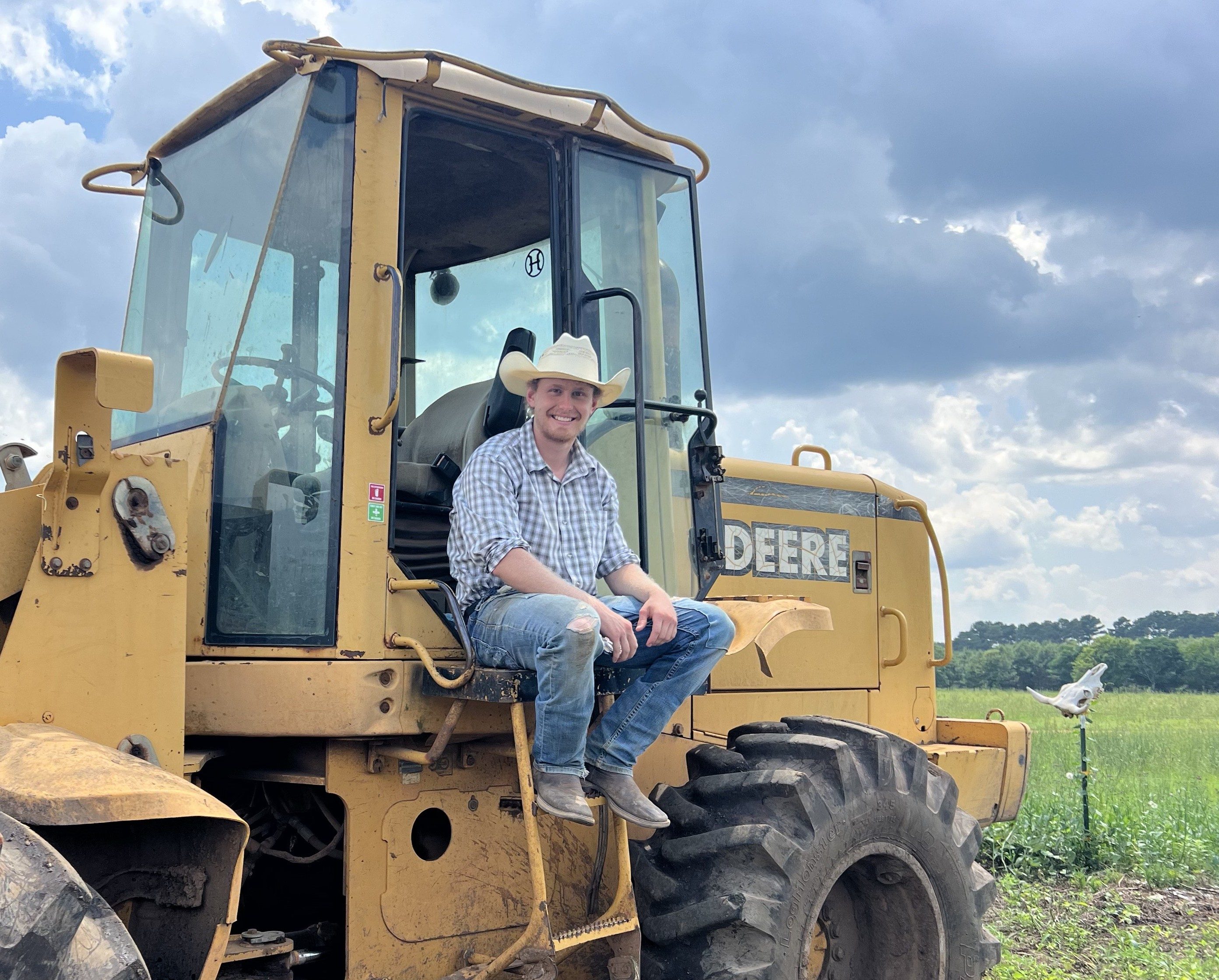TheFarmersDigest
The Farmers Digest
May 18, 2025

Editor
Chris Pigge

Editor
Miles Falk
The Basics of Cover Crops
Cover crops, plants grown primarily for soil improvement rather than harvest, represent a time-tested agricultural practice with modern applications across diverse farming operations. These strategic plantings between cash crop seasons protect and enhance soil while providing numerous ecosystem benefits. While the concept might seem straightforward—simply growing something when fields would otherwise be bare—the science behind cover cropping reveals complex interactions that can significantly improve agricultural sustainability and productivity.
How Cover Crops Work
Cover crops function by maintaining living roots in the soil during periods when primary crops are absent. These plants capture solar energy, convert it to carbon compounds, and distribute these resources both above and below ground. A substantial portion of the carbon fixed by cover crops is directed into the soil through root exudation and eventual plant decomposition, feeding soil life and building organic matter.
Different cover crop species contribute unique benefits based on their biological characteristics. Legumes form symbiotic relationships with bacteria to fix atmospheric nitrogen, while deep-rooted species like radishes can penetrate compacted soil layers. Cereal grasses typically produce abundant biomass that contributes organic matter.
Most farmers who have walked their fields after winter can notice the stark difference between bare soil and areas where cover crops have maintained soil structure and biological activity during the off-season.
The Benefits of Cover Crops
Enhanced Soil Health
Cover crops substantially improve soil physical, chemical, and biological properties. Long-term studies show that consistent cover crop use can significantly increase soil organic matter after just a few years. This improvement stems from continuous carbon inputs and reduced soil disturbance periods.
The difference resembles comparing the soil in a natural prairie to exposed construction site soil—one teems with life and structure, while the other lacks both.
Erosion Prevention
Protecting soil from water and wind erosion represents one of cover crops' most valuable functions. Research has found that rye cover crops can reduce soil erosion by more than half compared to bare fallow fields.
This protection occurs through two primary mechanisms: physical soil coverage by plant canopies and reinforcement through root systems. During heavy rainfall events, fields with established cover crops typically show significantly less runoff and sediment loss than bare fields.
Nutrient Management
Cover crops serve as living nutrient management systems, capturing mobile nutrients that might otherwise leach from the soil profile. Studies across the Midwest have documented that cereal rye cover crops can substantially reduce nitrogen leaching compared to leaving fields bare.
Beyond nutrient capture, certain cover crops—particularly legumes—contribute additional nutrients. Crimson clover, for example, can provide significant amounts of nitrogen per acre for subsequent crops, potentially reducing fertilizer needs.
Weed Suppression
Established cover crops compete effectively with weeds for resources while creating physical barriers to weed establishment. University field trials have found major reductions in weed biomass following fall-planted cereal rye cover crops compared to winter fallow.
This suppression works through several mechanisms: competition for light and nutrients, physical obstruction of weed seedling emergence, and sometimes through allelopathic compounds released by certain cover crop species that inhibit weed germination.
Beneficial Insect Habitat
Flowering cover crops provide habitat and resources for beneficial insects, potentially improving pollination and pest management in subsequent crops. Many farmers report seeing more predatory insects like ladybugs and ground beetles in their fields after implementing cover crops—natural allies in the ongoing challenge of pest management.
Cover Crops By The Numbers
- 60-90%Reduction in soil erosion with grass cover crops like rye compared to bare fields (Clark, 2007)
- Cover crops like rye and clover significantly enhance forage availability for livestock when integrated into grazing systems (USDA NRCS, 2019)
- 50-70%Reduction in weed pressure with cereal rye cover crops compared to bare fields (Penn State Extension, 2020)
- 30-50%Reduction in nitrogen leaching with cereal rye cover crops compared to bare fields (Clark, 2007)
- 0.5-1%Increase in soil organic matter content after 3-5 years of consistent cover crop use (Schnitkey et al., 2016)
- $15-45Typical per-acre cost range for cover crop implementation (Schnitkey et al., 2016)
- 40%Average increase in water infiltration rates in fields with established cover crops (USDA NRCS, 2021)
- Cover crops significantly improve water infiltration by enhancing soil structure and reducing compaction (USDA NRCS, 2019)
Types of Cover Crops and Their Applications
Legumes
Leguminous cover crops like clover, vetch, and winter peas excel at nitrogen fixation through their symbiotic relationship with rhizobia bacteria. Their nitrogen contributions can range from modest to substantial depending on species, biomass production, and termination timing.
Legumes typically decompose rapidly after termination, quickly releasing nutrients for subsequent crops. This makes them particularly valuable preceding high-nitrogen-demanding cash crops.
Grasses and Cereals
Cereal rye, oats, barley, and other grass species produce substantial biomass both above and below ground. The robust root systems of these cover crops are particularly effective at preventing erosion and improving soil structure. Even when planted late in the fall, cereal rye can produce over 4,000 pounds of biomass per acre (Pavek, 2017).
These cover crops generally have higher carbon-to-nitrogen ratios, resulting in slower decomposition and more persistent soil coverage after termination.
Brassicas
Radish, turnip, and mustard species feature rapid growth and distinctive tap roots that can penetrate compacted soil layers. Forage radish can penetrate compacted soils to depths of 12-30 inches, creating channels that improve water infiltration and subsequent crop root growth (Penn State Extension, 2020).
The decomposition of brassica tissue releases compounds that can suppress certain soil-borne pathogens and nematodes, potentially offering natural biocontrol benefits.
Cover Crop Mixes
Diverse cover crop mixtures combine complementary species to maximize benefits. Multi-species mixes enhance soil health, nutrient cycling, and pest suppression more effectively than monoculture cover crops (Clark, 2007).
These mixes often include representatives from multiple plant families to create synergistic effects—like pairing nitrogen-fixing legumes with carbon-contributing grasses.
Trade-Offs and Considerations
Implementing cover crops requires planning and management adjustments. The upfront costs include seed, planting operations, and eventual termination methods. These costs typically range from $15-45 per acre depending on seed selection and establishment methods.
Is it worth the investment? That depends on your operation's specific goals and constraints.
Timing represents another significant consideration, as cover crops must align with cash crop rotations. In shorter growing seasons, establishing adequate cover crop growth before winter can prove challenging. Some regions may require specialized strategies like interseeding cover crops into standing cash crops to ensure sufficient establishment time.
Water use by cover crops should be evaluated in moisture-limited environments. While cover crops can improve water infiltration and soil water-holding capacity over time, they do consume water during their growth cycle. In arid regions, termination timing may need careful management to preserve soil moisture for subsequent cash crops.
Practical Implementation Strategies
Getting Started
Beginning with a single species on a limited acreage allows farmers to gain experience with cover crops before expanding implementation. Select species that align with your primary goals—erosion control, nitrogen contribution, or compaction management—and that work within your existing rotation windows.
Establishing cover crops promptly after cash crop harvest dramatically improves success rates. Research from the University of Illinois found that each week of delayed planting in the fall reduced cereal rye biomass production by approximately 15% (University of Illinois Extension, 2023).
Many producers recommended starting small—perhaps on a particularly problematic field—rather than immediately implementing cover crops across entire operations.
Termination Methods
Cover crops can be terminated through various methods, including herbicides, roller-crimping, mowing, or natural winterkill, depending on species selection and management goals. Timing termination relative to cash crop planting influences nutrient release patterns and potential complications.
Early termination (2-3 weeks before planting) allows more decomposition time but may sacrifice some cover crop growth and benefits. Planting green—seeding cash crops directly into living cover crops before termination—maximizes cover crop growth but requires careful management of potential competition.
"Your termination plan should be in place before you ever plant the cover crop."— Kentucky farmer with 10+ years cover crop experience
Equipment Considerations
Most farmers can establish cover crops using existing equipment, though some modifications may enhance success. Drill seeding typically provides the most reliable establishment, while broadcast seeding with light incorporation can work well for certain species. Innovations like high-clearance seeders enable cover crop establishment into standing cash crops when post-harvest planting windows would be too short.
Cash crop planting into cover crop residue may require planter adjustments to manage residue and ensure proper seed placement. Row cleaners, downpressure systems, and closing wheel selections can significantly impact planting success in high-residue environments.
Real-World Applications
Row Crop Systems
A 1,200-acre corn and soybean operation in Illinois implemented cereal rye cover crops following corn harvest and before soybean planting. After four years, they documented a 3-5% increase in soybean yields and improved soil health, contributing to long-term productivity (Schnitkey et al., 2016).
Vegetable Production
A 75-acre diversified vegetable farm in California integrated vetch-oat cover crop mixes into their rotation between tomato crops. They achieved a 20-30% reduction in irrigation water requirements and improved nutrient retention after three years (University of California Cooperative Extension, 2016).
Orchard Systems
A Washington state apple orchard established permanent flowering cover crops in alleyways between tree rows. Researchers found increased beneficial insect populations and enhanced soil health, reducing irrigation requirements by 10-15% (Washington State University Extension, 2021).
Adapting Cover Crop Strategies to Your Operation
The flexibility of cover cropping allows adaptation to various agricultural systems, regardless of scale, equipment availability, or environment. Beginning with clear goals helps guide species selection and management decisions. Whether targeting erosion control, nitrogen management, or soil health improvement, identifying primary objectives ensures appropriate implementation strategies.
Start simple. Seriously.
Regional conditions significantly influence cover crop selection and management. Working with local extension services, experienced cover croppers in your area, or regional cover crop councils provides valuable insights into locally adapted strategies. These resources can help identify species that reliably winter-kill in your climate or that can establish effectively in your typical planting windows.
Many farmers delay implementation for years waiting for the "perfect" approach or complete understanding, missing benefits they could have been accumulating. Perfect truly is the enemy of good when it comes to cover cropping.
Conclusion
Cover crops offer a practical approach to enhancing soil health, managing nutrients, controlling erosion, and improving overall farm sustainability across diverse agricultural systems. While implementation requires planning and potential management adjustments, the documented improvements in soil quality, input efficiency, and system resilience provide substantial returns on this investment.
By working with biological processes rather than against them, cover cropping represents a management approach that can strengthen agricultural operations for the long term. It's not a cure-all—nothing in agriculture ever is—but for many operations, cover crops have become an indispensable component of successful management.
Give your soil the living cover it evolved with, and it might surprise you with what it gives back.
References
Penn State Extension. (2020). Cover Crops and Soil Health.
USDA NRCS. (2019). Cover Crops to Improve Soil in Prevented Planting Areas.
University of Georgia Extension. (2018). Cover Crop Management for Georgia Vegetable Growers.
University of Illinois Extension. (2020). Midwest Cover Crops Field Guide, 4th Edition.
Washington State University Extension. (2021). Cover Crops for Soil Health in Orchards.